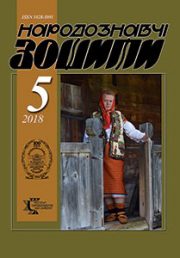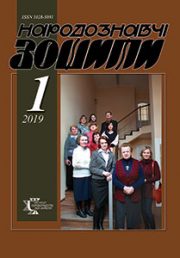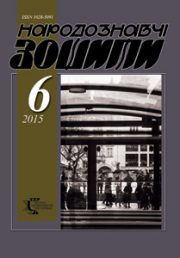The Ethnology Notebooks. 2018, № 4 (142), 907–912
UDK 94 “18”:75
DOI https://doi.org/10.15407/nz2018.04.907
Received 29.05.2018
REST, TAVERN AND WOMAN IN CHUMAKS TRAVELER’S LIFE (ACCORDING TO I.K. AIVAZOVSKYI’S PAINTINGS)
Filas Victor Nikolaevich – Candidate of Sciences in History, Associate Professor,
Khortytska National Academy, Department of Design,
Khortytsia Island, Scientific town Street, 59, 69017, Zaporizhia, Ukraine,
Contacts: (098) 4231818; e–mail: filasvn@gmail.com
Abstrakt. The article analyzes the I.K. Aivazovskyi’s paintings on the chumak topic and draws parallels with folk data and information of travel records of G.P. Danilevskyi and A.S. Afanasievа–Chuzhbynskyi. It is noted that the deviation from realism in the image is not an artist’s mistake, but the need for which the artist tries to transmit the maximum information about the chumaks traveler’s life. Analysis of the I.K. Aivazovskyi’s works allowed to determine the role of ta¬vern and woman in the chumaks traveler’s everyday life.
Keywords: visual source, woman, traveler’s life, I. Aivazovskyi, tavern, chumak.
REFERENCES
Barsamov, N.S. (1926). Aivazovskyi i Feodosyiskaia hallereia. Feodosyia: Izd. Feod. muzeia [in Ukrainian].
Barsamov, N.S. (1941). Ivan Konstantynovych Aivazovskyi. Moskva–Lenynhrad: Iskusstvo [in Russian].
Barsamov, N.S. (1962). Ivan Konstantynovych Aivazovskyi. 1817–1900. Moskva: Iskusstvo [in Russian].
Vahner, L.A., & Hryhorovych, N.S. (1970). Aivazovskyi. Moskva: Iskusstvo [in Russian].
Heiman, V. (1917). Y.K. Aivazovskomu, k stoletyiu so dnia rozhdenyia: 17yiulia 1817h. – 17 yiulia 1917 h. Feodosyia [in Ukrainian].
Danylevskyi,H.P (1956). Chumaky. Russkye ocherky. Iz putevykh zametok 1856 hoda. O nravakh i obychaiakh ukrainskykh chumakov. Moskva: Hoslytyzdat [in Russian].
Zhabtsev,V.N. (2008). Ivan Aivazovskyi. Mynsk: Kharvest [in Belarus].
Kuzmyn,N.N. (1901). I.K. Aivazovskyi i eho proizvedenyia. Sankt–Peterburh: Typ. Bulhakova [in Russian].
Mazyrov, L.E. (1888). Yvan Konstantynovych Aivazovskyi. Po povodu eho piatydesiatyletneho yubyleia. In Sbornyk statei yz «Pravytelstvennoho vestnyka». Sankt–Peterburh: Typ Bulhakova [in Russian].
Nykolaeva, N.K.(1914). Y.K. Aivazovskyi. Moskva: Yzd. Maevskoho [in Russian].
Pylypenko, V.N., Teliupa, S. (Upor.). (1991). Yvan Konstantynovych Aivazovskyi. Lenynhrad: Khudozhnyk RSFSR [in Russian].
Riabkov, P. (2010). Chumatstvo. Zaporizhzhia: Tandem–U [in Ukrainian].
Sarhsian, M.S. (2010). Zhyzn velykoho marynysta: Ivan Konstantynovych Aivazovskyi. Feodosyia: Koktebel [in Ukrainian].
Semevskyi, M.Y. (1877). Ivan Konstantynovych Aivazovskyi. K vospomynanyiam o eho yubylee 26–ho sentiabria 1877 h. Russkaia staryna. Noiabr [in Russian].
Semevskyi, M.Y. (1877). Ivan Konstantynovych Aivazovskyi. Poluvekovaia hodovshchyna eho khudozhestvennoi deiatelnosty. Russkaia staryna. Oktiabr [in Russian].
Sobkov, Y.P. (1893). Aivazovskyi Ivan Konstantynovych. In Slovar russkykh khudozhnykov: S drevneishykh vremen do nashykh dnei (XI–XIX vv.). Na osnovanyy letopysei, aktov, arkhyvnykh dokumentov, avtobyohrafycheskykh zametok i pechatnykh materyalov (Vol. 1, part. 1, p. 324). Sankt–Peterburh: Typ. M.M. Stasiulevycha [in Russian].
Khachatrian, Sh.S. (2000). Aivazovskyi izvestnyi i neyzvestnyi. Samara: Ahny [in Russian].
Rudchenko, Y.Ia, (1874). Chumatskyia narodnyia pesni. Kyev: Typ. M.P. Frytsa [in Ukrainian].
Yakovlev, V.N. (1952). O velykykh russkykh khudozhnykakh. Moskva: Iskusstvo [in Russian].






